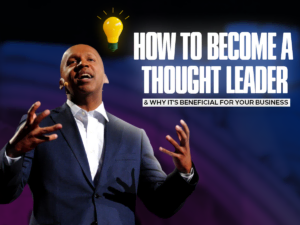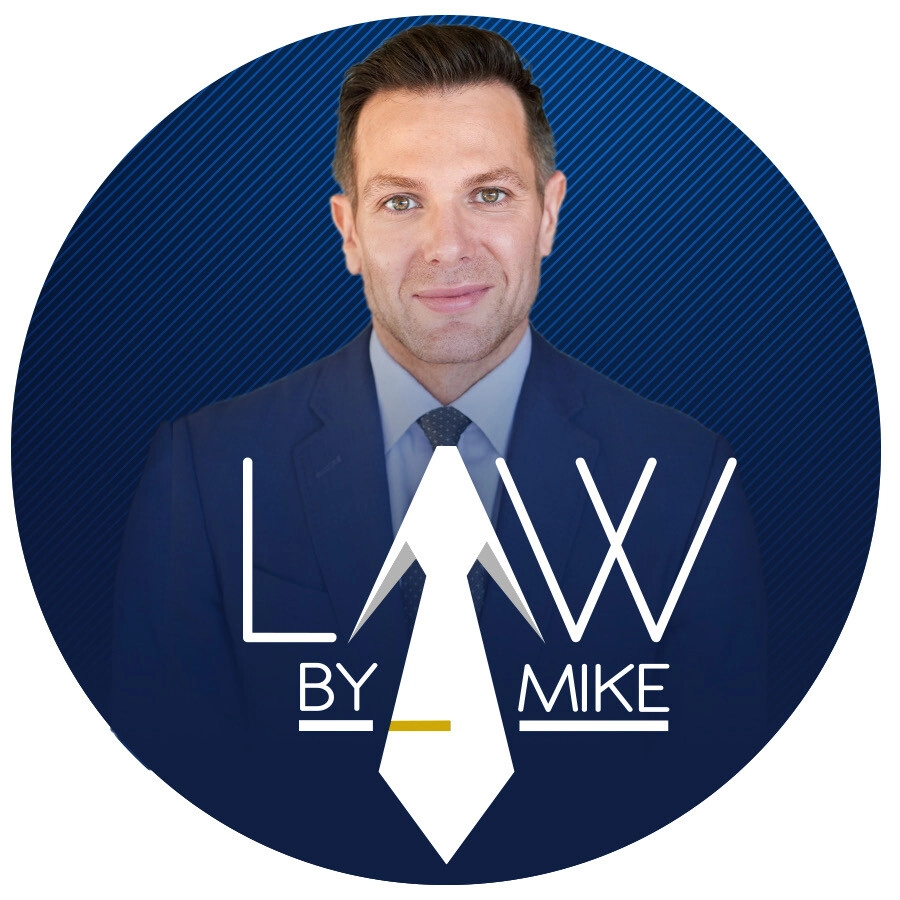In a world filled with abundant content and fierce competition, thought leadership goes beyond being a mere buzzword. It is strategically significant for individuals and brands seeking to establish themselves uniquely in their respective industries. But what exactly does developing a thought leadership plan entail?
Simply put, thought leadership involves positioning oneself as an expert and visionary in a specific field, leading conversations, and driving innovation. Thought leaders are the go-to individuals within their areas of expertise. They are the trusted sources who inspire others with groundbreaking ideas, transform those ideas into reality, and possess the knowledge to guide others toward replicating their success.
By the time you finish reading this comprehensive blog post, you will not only understand the importance of thought leadership but also gain practical insights on creating an effective strategy that solidifies your reputation as an authority in your industry.

Why is Developing a Thought Leadership Plan Important?
In today’s fiercely competitive business landscape, thought leadership is more than just an advantage—it is a fundamental pillar. Here is a brief overview of its pivotal significance:
Builds Credibility and Trust
Thought leadership builds deep trust among audiences by establishing you as a reliable resource within your industry. It involves transforming expertise into a valuable form of trust that yields customer loyalty and strengthens your brand.
Differentiates You From Your Competitors
Thought leaders distinguish themselves from the crowd by presenting innovative insights. This sets them apart in terms of reputation and highlights the unique value they bring, which separates them from their competition.
Garners an Influence
Being a thought leader goes beyond mere commentary; it involves shaping industry conversations and inspiring others. This ability to influence not only impacts perceptions but also drives actions within the market.
Fosters Growth
Thought leadership has been proven to drive growth by attracting leads and nurturing customer relationships through consistent value. By embedding your brand in the very fabric of your industry’s future, you pave the way for long-term success.
Types of Thought Leaders
Thought leadership can take on various forms. Here are a few examples:

The Innovator
Innovators are pioneers of new ideas who constantly unveil the “next big thing” and push boundaries in technology and creativity. Their leadership sparks revolutions and transforms industries.
The Educator
These thought leaders serve as mentors and teachers, generously sharing wisdom and skills. They create a ripple effect of knowledge that enables others to grow and excel through their insights and guidance.
The Advocate
Passionate and purpose-driven, Advocates use their voice to champion causes and drive societal or industry-wide change. They gather support and lead movements, transforming beliefs into action.
The Researcher
Drawing from factual data, Researchers lead with evidence and statistics. They dive deep into the intricacies of data to uncover trends and truths, offering well-supported perspectives that cut through the noise and speculation.
Each category brings a distinct blend of expertise and foresight to the table, defining the qualities that contribute to being a successful thought leader. Identifying the type of thought leader you want to become is a key step in developing a thought leadership plan.
Benefits of Thought Leadership for a Brand/Company
Thought leadership is a potent tool for any brand or company, providing benefits that impact every aspect of the business.
Building Authority
When a company is recognized as a thought leader, it becomes the primary expert in its field. This recognition fosters trust in the company, enhancing its reputation and influence.
Increasing Engagement
People enjoy reading and sharing insightful content from thought leaders. This translates to more people discussing the company and establishing more substantial connections with the audience.
Recruiting Top Talent
Top-tier professionals aspire to join companies that are leaders and innovators. Being acknowledged as a thought leader makes a company more appealing to these talented individuals.
Boosting Sales
If a company is renowned for its expertise, selling becomes more effortless. Customers already have a high level of trust in the company, making them more inclined to make quick purchases.
In simple terms, thought leadership plays a vital role in helping a company differentiate itself, attract supporters and talented individuals, and facilitate smoother sales. It’s not solely about having great ideas; it’s about being recognized as an authoritative figure in your field.
10 Steps to Developing a Thought Leadership Plan
Embarking on the journey to become a thought leader is a strategic process that involves a series of calculated steps. If you’re aiming to elevate yourself or your brand to thought leadership status, here’s a roadmap to guide you:
Step 1: Identify Your Niche
Focus on the area where your expertise truly shines. Discover that unique aspect in which you excel beyond anyone else.
Step 2: Develop Your Distinct Perspective
What are your insights on topics that aren’t commonly discussed? Craft an original viewpoint that will capture people’s attention.
Step 3: Create Compelling Content
Produce valuable content such as articles, videos, or podcasts that showcase your expertise and share your profound insights.
Step 4: Engage with Your Community
Don’t just broadcast information; actively engage with others. Utilize social media platforms, attend events, and network to establish genuine relationships within your community.
Step 5: Collaborate with Other Thought Leaders
Join forces with colleagues who share your insights. Their endorsement can help increase your reach and add credibility to your ideas.
Step 6: Keep Expanding Your Knowledge
The world is constantly evolving, and so should your understanding. Stay updated and adaptable to maintain your position as an expert.
Step 7: Stay Persistent
Thought leadership requires ongoing effort. Keep creating content and engaging with your audience to stay top of mind.
Step 8: Seek Feedback and Improve
Pay attention to what your audience has to say. Their feedback can be valuable in refining your message and ensuring it resonates with them.
Step 9: Measure Your Impact
Take a look at the data. Monitor engagement, reach, and the influence of your content to identify areas of success and improvement.
Step 10: Adapt Your Strategy
As you gain influence, adapting and expanding your strategies is crucial. Evolve your approach to sustain growth in thought leadership.
Following these ten steps will set you on a path toward becoming a recognized thought leader. It’s not just about possessing knowledge; it’s about sharing it consistently in a way that holds value for your audience while staying connected with the community you’re building.
How to Implement Thought Leadership
To effectively demonstrate thought leadership, it’s important to share your valuable insights with others. Here are some effective strategies to accomplish that:
Maintain a Blog
Consistently update a blog where you can share your expertise and insights. This platform allows you to provide fresh content and address relevant topics that resonate with your audience.
Engage in Speaking Opportunities
Seek opportunities to speak at industry conferences, workshops, or webinars. These events provide an engaged audience that is already interested in your area of expertise.
12 Proven Tips for Preparing for a Media Interview
Preparing for a media interview? Use our 12 proven tips to guarantee success in your next TV, radio, or podcast interview.
Utilize Social Media
Use social media platforms to share snippets of your knowledge, interact with followers, and participate in broader conversations. This will help you build a community around your thought leadership.
Publish Books and Articles
If you’re ready to dive deeper, consider writing a book or publishing articles in well-known publications. Creating long-form content allows you to explore complex subjects and provide comprehensive insights.
When brainstorming content ideas, focus on delivering real value to your audience. For example, case studies showcase the application of your strategies to guide readers in achieving specific goals, while industry analyses offer an overview of trends and changes.
The most important aspect is aligning your content format with your message and your audience’s preferences. This ensures that not only will your thought leadership be heard, but it will also be appreciated and put into practice.
Real Life Examples of Thought Leadership
Let’s take a look at three individuals who have successfully established themselves as thought leaders in their respective industries;
1. Simon Sinek: Focusing on Leadership and Organizational Culture
Simon Sinek gained recognition as a thought leader in the realm of leadership and organizational culture through his book “Start With Why” and a TED talk that has become one of the most widely viewed talks ever. He introduced “The Golden Circle” concept, emphasizing how companies should begin with their ‘why’—their purpose, cause, or belief—to inspire action. Sinek’s unique leadership approach and innovative models have significantly influenced how many executives approach team building and company culture, highlighting the significance of purpose-driven leadership.
2. Gary Vaynerchuk: Digital Marketing and Entrepreneurship
Gary Vaynerchuk, popularly known as GaryVee, has emerged as a thought leader in the digital marketing and entrepreneurship domain. By effectively utilizing social media platforms and creating an extensive range of content, he has positioned himself as an authority on consumer behavior, social media trends, and personal brand development.
His straightforward and practical advice for aspiring entrepreneurs and marketers has gained a massive following and transformed how many people perceive brand interaction on digital platforms.
3. Sheryl Sandberg: Empowerment and Gender Equality in the Workplace
Sheryl Sandberg, former Chief Operating Officer of Facebook and the author of “Lean In,” has emerged as a prominent figure in advocating for gender equality and empowering women in corporate settings. Her work has sparked global discussions about the obstacles women face in their careers and how societal norms and organizational structures can evolve to support women’s professional growth. Sandberg’s influence has prompted numerous companies to reevaluate their policies and work culture to foster a more inclusive environment.
These influential individuals have utilized their expertise, experiences, and unique perspectives to drive conversations and bring about change within their respective industries. This showcases the significant impact that becoming a thought leader has on shaping public discourse and industry norms by have effectively sharing their insights through various channels, including books, public speaking engagements, and social media platforms.
The Impact of PR on Developing a Thought Leadership Plan
Public Relations (PR) plays a vital role in elevating individuals or brands to thought leadership status. It acts as the driving force behind this journey by ensuring your voice reaches the right audience while establishing your credibility as an authority figure. Let’s take a closer look at how PR can have a significant impact when creating an effective thought leadership strategy.

Increased Visibility
PR strategies are designed to spotlight your work, ensuring that your ideas and insights reach a broad audience. With careful planning and execution, PR strengthens the connection between you and your target audience, ensuring you are noticed where it matters most.
Managing Reputation
In the realm of thought leadership, reputation is crucial. PR plays a vital role in shaping a positive and authoritative image for you or your brand. It acts as both a proactive and reactive tool—celebrating successes and defending your standing when needed—to maintain the integrity and respect of your public persona.
Strategic Communication
PR goes beyond simply delivering messages; it focuses on crafting them purposefully. PR ensures consistency and coherence by aligning communication efforts with the broader goals of thought leadership. This strategic approach amplifies your voice, ensuring it resonates effectively with your intended audience.
Building Media Relations
Having access to media outlets is fundamental for establishing thought leadership. Through PR professionals, doors open to interviews, op-eds, feature articles, and various other media opportunities that might otherwise be out of reach. These platforms play a crucial role in sharing your vision and expertise with a broader audience, which helps establish your position as a respected thought leader.
PR is an invaluable tool for individuals aspiring to be thought leaders. It goes beyond just getting your name out there; it involves creating a narrative of expertise, maintaining a reputable image, and effectively communicating your vision to the world. Each aspect of PR works together to elevate your influence and standing, making it an essential ingredient in the recipe for becoming a thought leader.

In conclusion, embracing thought leadership is not merely about gaining authority; it’s about contributing value to your industry and audience. As the digital realm continues to expand, there is an increasing need for genuine leaders willing to explore uncharted territories and share their insights.
Choosing Otter PR
How to Create Effective PR Growth Strategies: 10-Step Guide
Discover how PR growth strategies can propel your business forward. Dive into the essentials of PR, its benefits, and a step-by-step guide to maximize brand success.
When embarking on your journey to becoming a thought leader, choosing the right partner is vital. Otter PR stands out as an innovative force in cultivating thought leaders and authorities in various industries through personalized strategies, an extensive network of media contacts, and a deep understanding of the digital landscape.
Lastly, remember that thought leadership is not something you pursue alone. By partnering with a seasoned PR firm like Otter PR, you can enhance your voice and ensure that your message reaches and profoundly resonates with the right audience. The future holds countless opportunities for those prepared to embrace thought leadership. Are you ready to step up and lead the conversation?
The benefits of PR in helping you achieve this goal are crystal clear: strategic positioning, consistent messaging, and a profound understanding of the media landscape can elevate your reputation and guide you toward becoming a recognized thought leader. Take the leap today and witness doors open to an entirely new level of influence and success.





